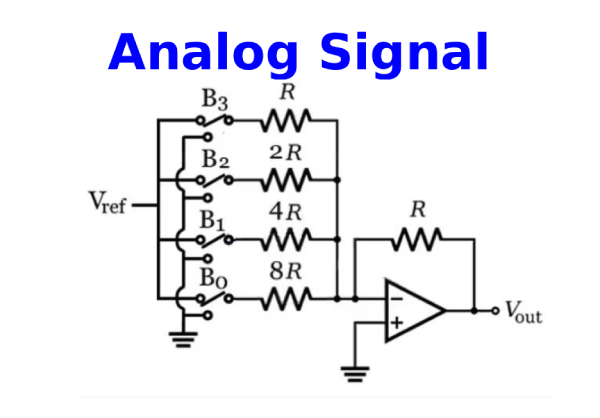

What is an Analog Signal? Meaning & Definition
Catalog
What is an analog electrical signal?Analog Signal ProcessingCommon Tools for Analog Signal ProcessingMeasuring Analog SignalsInformation Obtained from an Analog SignalUsing an Oscilloscope to Measure Analog SignalsAnalog vs. Digital OscilloscopesKey TermsPopular Used OscilloscopesFrequently Ask QuestionsRelated ArticlesA signal is simply an electrical form of data. It can carry messages, images, sounds, measurements, or any other information expressed as a set of values.
In this article, we’ll look at analog signals—what they are, how they work, and the tools used to process them. Unlike digital signals, which are made up of separate, fixed values at specific intervals, analog signals are continuous and can take on infinitely small variations between points.

What is an analog electrical signal?
An analog signal is a voltage, current, or physical quantity that changes smoothly and continuously over time, following some time-dependent parameter. Examples include radio waves, TV signals, and sound waves.
There are two main kinds of analog signals:
- Continuous-time signals: Any function that varies continuously with time. A classic example is a sinusoidal wave.
- Discrete-time signals: A sequence of values measured at evenly spaced time intervals. A common example is a digital audio signal, which records instantaneous amplitudes at equal time steps.
Analog Signal Processing
Analog signal processing uses electronic circuits and devices to perform operations on continuous analog signals—such as amplification, filtering, and limiting. It involves continuous-time processing, where quantities change smoothly over time.
Common Tools for Analog Signal Processing
- Oscilloscope: An oscilloscope lets engineers observe the real-time behavior of an electrical circuit. The test signal is sent from the circuit into the scope’s input channel and displayed as a waveform on the screen.
- Power Supplies: These devices convert electrical power into a usable form, often transforming low-voltage, high-current input into stable, regulated output suitable for electronic testing.
- Function Generators: A function generator produces different types of waveforms used for testing circuits or creating audio signals. Typical output waveforms include sine, triangle, square, sawtooth, pulse, and ramp, selectable from the front panel.
- Analog Audio Signal Generators: These generate signals within the audio frequency range. They typically use a voltage-controlled oscillator or pulse train, followed by an amplifier, before sending the output to speakers or measurement systems.
- RF Analog Signal Generators: Designed for higher-frequency applications, these generators produce signals such as sine waves, square waves (pulses), triangle, or sawtooth waveforms. They can also sweep across a set frequency range for testing RF circuits.
Measuring Analog Signals
The amplitude of an analog signal is measured in volts, while its frequency is measured in hertz (Hz). For a sine wave, the peak-to-peak amplitude is expressed in volts. The connection between voltage and current can also be described using Ohm’s Law:
Voltage = Current × Resistance
Voltage is one of the most practical and widely used forms of electrical energy, as it is easier to measure and requires less space compared to other forms like current.
Information Obtained from an Analog Signal
Analog signals carry three key types of information:
- Magnitude (Amplitude) The amplitude represents the size of the signal, usually measured in volts. For an AC sine wave, this can be expressed as either its peak-to-peak value or its average value. For example, if two sine waves share the same frequency but have different amplitudes, they will appear differently on an oscilloscope—the larger amplitude will produce a taller waveform.
- Frequency Frequency describes how often a waveform repeats per second, measured in hertz (Hz). It is the number of cycles per second, or in angular terms, radians per second. Two sine waves with the same amplitude but different frequencies will look different—the higher frequency wave will have more cycles in the same time span.
- Phase Phase indicates the position of a waveform relative to another waveform with the same frequency and amplitude. In simple terms, it shows how much one signal is “ahead” or “behind” another in time. On an oscilloscope, a phase difference shifts the wave horizontally along the time axis.
Using an Oscilloscope to Measure Analog Signals
An oscilloscope is an instrument used to visualize time-varying signals as waveforms on a screen. When measuring analog signals, the display may show either an AC (alternating current) signal or a pulsed DC (direct current) signal.
- AC signal: A voltage or current that repeatedly reverses polarity over time.
- DC signal: A voltage or current that maintains a constant polarity.
Analog vs. Digital Oscilloscopes
- An analog oscilloscope directly displays the signal waveform using continuous vertical and horizontal deflection.
- A digital oscilloscope digitizes the incoming signal through a process called sampling. The instrument takes snapshots of the signal at discrete time intervals, then plots these values as voltage levels along the time axis (x-axis).
Display Characteristics
- Analog oscilloscopes can represent signals using both vertical and horizontal deflection.
- Digital oscilloscopes, however, primarily display waveforms along the horizontal (time) axis.
Performance Differences
- Analog oscilloscopes typically offer wider bandwidths but slower sweep speeds. Since the signal must be redrawn for every update, there can be slight delays that affect bandwidth and measurement speed.
- Digital oscilloscopes often provide faster sweep speeds but narrower bandwidths, as their performance depends on sampling rates and processing power.
Measuring Voltage Signals with an Oscilloscope
A voltage signal is measured by its amplitude, which represents its strength or intensity. Measurements are usually taken with respect to ground, since having a reference point makes the signal easier to interpret.
In some cases, both positive and negative voltages are involved in an experiment. To display both polarities of the waveform at the same time, the oscilloscope must use two vertical channels—one for each input being monitored.
Controls on an Analog Oscilloscope
An analog oscilloscope has several controls that determine how an input signal is displayed on the screen. The main controls include:
- Vertical Gain
- Horizontal Time Base
- Trigger Mode
- Marker Settings
Vertical Gain
The vertical gain control adjusts how much the signal’s amplitude is scaled vertically on the display. This lets you make small signals appear larger or keep large signals within view.
Horizontal Time Base
The time base control determines how the oscilloscope displays the signal over time. It sets the amount of time represented across each division of the horizontal axis, typically adjusted with knobs or buttons labeled with time units such as “µs/DIV.”
Trigger Mode
The trigger system stabilizes repetitive waveforms by controlling when the oscilloscope begins drawing the signal. Depending on the input, you can select modes such as AUTO, EXT TRIG, or INT TRIG to ensure the waveform is displayed clearly without drifting.
Marker Settings
Markers allow you to measure values directly on the waveform, such as voltage levels or time intervals. Depending on the settings, these markers may appear as dots or ticks on the trace to help with quick, precise measurements.
Key Terms
The following table explains important terms related to signals:
| Term | Definition |
|---|---|
| Duty Cycle | The ratio of the signal’s ON time to its total period, expressed as a percentage: (ON time ÷ Period) × 100%. |
| Rise Time | The time it takes for a signal to transition from a low level (typically 10% of its maximum value) to a high level (90%). Commonly applies to digital signals. |
| Fall Time | The time it takes for a signal to transition from a high level (typically 90%) down to a low level (10%). Also applies mainly to digital signals. |
| Frequency Content | The range of frequencies present within a signal. Relevant for analog signals or pulse inputs, since sine waves inherently represent a single frequency. |
| Crest Factor | The ratio of a waveform’s peak value to its RMS (average power) value. Useful for signals with high peaks compared to their average level. |
| Bandwidth | The range of frequencies an electronic system, device, or circuit can transmit or process effectively. |
| Noise Level | The unwanted background signals or fluctuations present in a circuit, often measured as voltage or power over a frequency range. |
| Analog Frequency (Baseband Signal) | A continuous waveform that directly carries information, often serving as the basis for digital modulation. |
| Multiplexer for Analog Signals | A device that combines multiple analog signals to share a single communication channel or bandwidth. |
| Analog Signal Delay Circuit | A circuit that stores an incoming analog signal for a set time before releasing it, often used for synchronization or timing adjustments. |
| Analog Signal Amplifier Circuit | A circuit that increases the strength of an analog signal. Amplifiers can be linear (faithfully reproducing the input) or non-linear (introducing distortion for specific purposes). |
| Analog Signal Modulation | A technique of transmitting information by varying the amplitude, frequency, or phase of a carrier wave. Example: AM radio uses amplitude modulation of a sine wave. |
Popular Used Oscilloscopes
JMBom Used Oscilloscopes provides a wide selection of industry-leading pre-owned instruments, from classic Agilent models to the latest JMBom oscilloscopes. Whether you’re a first-time buyer, replacing an existing unit, or upgrading to a more advanced model, we have the right solution for you.
Frequently Ask Questions
What is an Analog Signal in Simple Terms?
An analog signal is a continuous signal that represents real-world measurements like current, voltage, temperature, pressure, or light intensity. It changes smoothly over time and amplitude.
Is HDMI an Analog Signal?
No, HDMI carries digital audio and video signals—not analog. If you want to use analog audio sources with HDMI, you need to convert them to digital first.
What Does Analog Mean for Beginners?
Analog refers to circuits where values like voltage or current change continuously. For example, turning a potentiometer knob changes resistance gradually, not in steps.
Is Voltage Analog or Digital?
Voltage signals can be analog, such as 0-5V, 0-10V, 1-5V, or 4-20mA signals. Digital signals use communication protocols like RS-485 with Modbus, BACnet®, PROFIBUS, or I2C.
Are TV Signals Analog or Digital?
TV signals used to be analog, but since 1996, digital broadcasting has become standard. Today, the FCC requires TVs to have digital tuners, and most stations broadcast digitally.
Related Articles
Guide to Potentiometers and How to Connect Them
Guide to Series and Parallel Circuits
How to Use a Multimeter to Check a Switch
How to Measure RF Power Using a Spectrum Analyzer
How to Charge Lithium Battery:Steps
What is a Complementary Metal Oxide Semiconductor (CMOS)?
Parallel Resistor Calculator & A Practical Guide for Electrical Engineers
Subscribe to JMBom Electronics !













